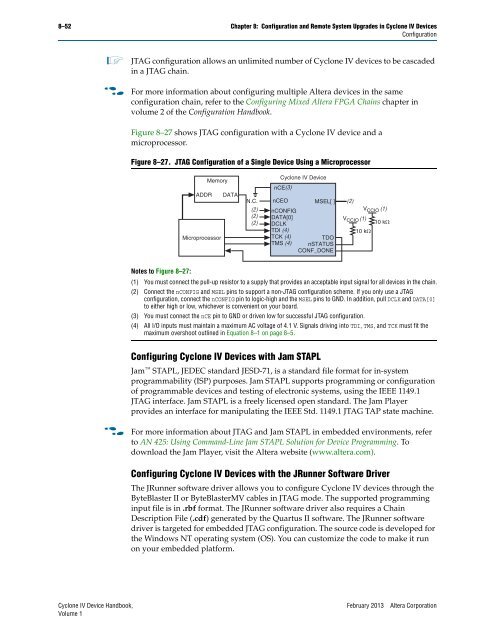Configuration and Remote System Upgrades in Cyclone IV ... - Altera
Configuration and Remote System Upgrades in Cyclone IV ... - Altera
Configuration and Remote System Upgrades in Cyclone IV ... - Altera
Create successful ePaper yourself
Turn your PDF publications into a flip-book with our unique Google optimized e-Paper software.
8–52 Chapter 8: <strong>Configuration</strong> <strong>and</strong> <strong>Remote</strong> <strong>System</strong> <strong>Upgrades</strong> <strong>in</strong> <strong>Cyclone</strong> <strong>IV</strong> Devices<br />
<strong>Configuration</strong><br />
1 JTAG configuration allows an unlimited number of <strong>Cyclone</strong> <strong>IV</strong> devices to be cascaded<br />
<strong>in</strong> a JTAG cha<strong>in</strong>.<br />
f For more <strong>in</strong>formation about configur<strong>in</strong>g multiple <strong>Altera</strong> devices <strong>in</strong> the same<br />
configuration cha<strong>in</strong>, refer to the Configur<strong>in</strong>g Mixed <strong>Altera</strong> FPGA Cha<strong>in</strong>s chapter <strong>in</strong><br />
volume 2 of the <strong>Configuration</strong> H<strong>and</strong>book.<br />
Figure 8–27 shows JTAG configuration with a <strong>Cyclone</strong> <strong>IV</strong> device <strong>and</strong> a<br />
microprocessor.<br />
Figure 8–27. JTAG <strong>Configuration</strong> of a S<strong>in</strong>gle Device Us<strong>in</strong>g a Microprocessor<br />
Notes to Figure 8–27:<br />
ADDR<br />
Memory<br />
Microprocessor<br />
DATA<br />
N.C.<br />
<strong>Cyclone</strong> <strong>IV</strong> Device<br />
nCE(3)<br />
nCONFIG<br />
DATA[0]<br />
DCLK<br />
TDI (4)<br />
TCK (4)<br />
TDO<br />
TMS (4) nSTATUS<br />
CONF_DONE<br />
(1) You must connect the pull-up resistor to a supply that provides an acceptable <strong>in</strong>put signal for all devices <strong>in</strong> the cha<strong>in</strong>.<br />
(2) Connect the nCONFIG <strong>and</strong> MSEL p<strong>in</strong>s to support a non-JTAG configuration scheme. If you only use a JTAG<br />
configuration, connect the nCONFIG p<strong>in</strong> to logic-high <strong>and</strong> the MSEL p<strong>in</strong>s to GND. In addition, pull DCLK <strong>and</strong> DATA[0]<br />
to either high or low, whichever is convenient on your board.<br />
(3) You must connect the nCE p<strong>in</strong> to GND or driven low for successful JTAG configuration.<br />
(4) All I/O <strong>in</strong>puts must ma<strong>in</strong>ta<strong>in</strong> a maximum AC voltage of 4.1 V. Signals driv<strong>in</strong>g <strong>in</strong>to TDI, TMS, <strong>and</strong> TCK must fit the<br />
maximum overshoot outl<strong>in</strong>ed <strong>in</strong> Equation 8–1 on page 8–5.<br />
Configur<strong>in</strong>g <strong>Cyclone</strong> <strong>IV</strong> Devices with Jam STAPL<br />
(2)<br />
VCCIO (1)<br />
VCCIO (1)<br />
10 kΩ<br />
10 kΩ<br />
Jam STAPL, JEDEC st<strong>and</strong>ard JESD-71, is a st<strong>and</strong>ard file format for <strong>in</strong>-system<br />
programmability (ISP) purposes. Jam STAPL supports programm<strong>in</strong>g or configuration<br />
of programmable devices <strong>and</strong> test<strong>in</strong>g of electronic systems, us<strong>in</strong>g the IEEE 1149.1<br />
JTAG <strong>in</strong>terface. Jam STAPL is a freely licensed open st<strong>and</strong>ard. The Jam Player<br />
provides an <strong>in</strong>terface for manipulat<strong>in</strong>g the IEEE Std. 1149.1 JTAG TAP state mach<strong>in</strong>e.<br />
f For more <strong>in</strong>formation about JTAG <strong>and</strong> Jam STAPL <strong>in</strong> embedded environments, refer<br />
to AN 425: Us<strong>in</strong>g Comm<strong>and</strong>-L<strong>in</strong>e Jam STAPL Solution for Device Programm<strong>in</strong>g. To<br />
download the Jam Player, visit the <strong>Altera</strong> website (www.altera.com).<br />
Configur<strong>in</strong>g <strong>Cyclone</strong> <strong>IV</strong> Devices with the JRunner Software Driver<br />
The JRunner software driver allows you to configure <strong>Cyclone</strong> <strong>IV</strong> devices through the<br />
ByteBlaster II or ByteBlasterMV cables <strong>in</strong> JTAG mode. The supported programm<strong>in</strong>g<br />
<strong>in</strong>put file is <strong>in</strong> .rbf format. The JRunner software driver also requires a Cha<strong>in</strong><br />
Description File (.cdf) generated by the Quartus II software. The JRunner software<br />
driver is targeted for embedded JTAG configuration. The source code is developed for<br />
the W<strong>in</strong>dows NT operat<strong>in</strong>g system (OS). You can customize the code to make it run<br />
on your embedded platform.<br />
<strong>Cyclone</strong> <strong>IV</strong> Device H<strong>and</strong>book, February 2013 <strong>Altera</strong> Corporation<br />
Volume 1<br />
(2)<br />
(2)<br />
(2)<br />
nCEO<br />
MSEL[ ]
















